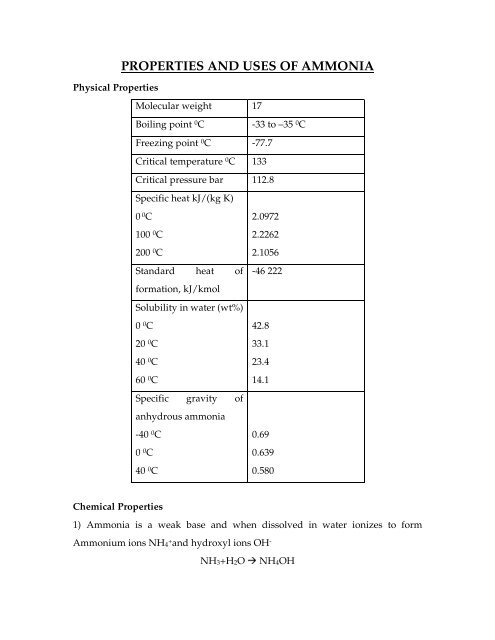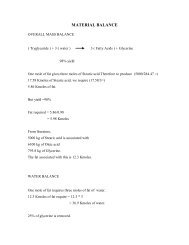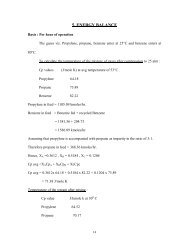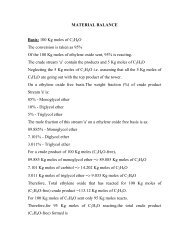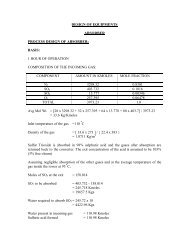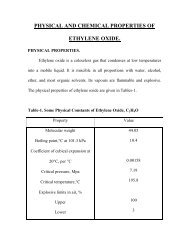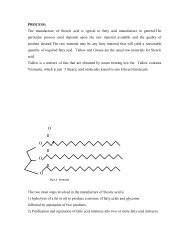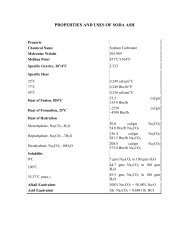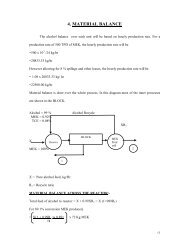PROPERTIES AND USES OF AMMONIA - s ...
PROPERTIES AND USES OF AMMONIA - s ...
PROPERTIES AND USES OF AMMONIA - s ...
You also want an ePaper? Increase the reach of your titles
YUMPU automatically turns print PDFs into web optimized ePapers that Google loves.
Physical Properties<br />
<strong>PROPERTIES</strong> <strong>AND</strong> <strong>USES</strong> <strong>OF</strong> <strong>AMMONIA</strong><br />
Molecular weight 17<br />
Boiling point 0 C<br />
-33 to –35 0 C<br />
Freezing point 0 C -77.7<br />
Critical temperature 0 C 133<br />
Critical pressure bar 112.8<br />
Specific heat kJ/(kg K)<br />
0 0 C<br />
100 0 C<br />
200 0 C<br />
Standard heat of<br />
formation, kJ/kmol<br />
2.0972<br />
2.2262<br />
2.1056<br />
-46 222<br />
Solubility in water (wt%)<br />
0 0 C<br />
20 0 C<br />
40 0 C<br />
60 0 C<br />
42.8<br />
33.1<br />
23.4<br />
14.1<br />
Specific gravity of<br />
anhydrous ammonia<br />
-40 0 C<br />
0 0 C<br />
40 0 C<br />
0.69<br />
0.639<br />
0.580<br />
Chemical Properties<br />
1) Ammonia is a weak base and when dissolved in water ionizes to form<br />
Ammonium ions NH4 + and hydroxyl ions OH -<br />
NH3+H2O Æ NH4OH
2) Ammonia forms ammonium salts and water with acids<br />
NH3 + H2SO4 Æ (NH4)2SO4<br />
NH3 + HCl Æ NH4Cl<br />
3) Ammonia solution precipitates most metal hydroxides from solutions of their<br />
salts. In some cases like copper the hydroxide is soluble in excess owing to<br />
formation of complex ion.<br />
CuSO4 + 2NH4OH Æ Cu(OH)2 +(NH4)2SO4<br />
Cu(OH)2 Æ Cu 2+ +2OH -<br />
Cu 2+ +4NH3 Æ [Cu(NH3)4} 2+<br />
4)Ammonia does not burn readily in air, nor is it a supporter of combustion, but<br />
warm ammonia burns in Oxygen to form nitrogen and water.<br />
4NH3 + 3O2 Æ 2N2 +6H2O<br />
In the presence of platinum guaze and other cataltsts, oxides of nitrogen and<br />
ammonium nitrate are formed.<br />
5) Ammonia is a relatively stable compound. When strongly heated or sparked it<br />
decomposes into its constituent elements.<br />
2NH3 Æ N2 +3H2<br />
6) Ammonia behaves as mild reducing agent. It reduces many heated metallic<br />
oxides like CuO PbO etc<br />
3CuO + 2NH3 Æ 3Cu + N2 +3H2O<br />
7)Ammonia reacts with halogens to give ammonium halides.<br />
8NH3 + 3Cl2 Æ N2 + 6NH4Cl<br />
with excess halogens it forms dangerously explosive nitrogen trihalides.<br />
8) Ammonia reacts with certain metals when heated. Sodium forms Sodamide<br />
and hydrogen.<br />
2Na + 2NH3 Æ 2NaNH2 + H2
<strong>USES</strong> <strong>OF</strong> <strong>AMMONIA</strong><br />
Ammonia is the single most widely used compound in the fertilizer industry. It<br />
is the starting material for the production of a various number of nitrogenous<br />
fertilizers like ammonium phosphates, ammonium sulfate, ammonium nitrate<br />
etc.<br />
It is used directly or indirectly as the source for the production of<br />
hexamethylenedeamine for the manufacture of nylon 6,6. In the manufacture of<br />
rayon, ammonia is used in the preparation of ammoiacal copper hydroxide<br />
soulutio for dissolving the copper linters. Oxidation of propylene with ammonia<br />
gives acrylonitrile, used for the manufacture of acrylic fibres, resins, and<br />
elastomers.<br />
Hexamethylenetetramine, produced from ammonia and formaldehyde, is used<br />
in the manufacture of phenolic thermosetting resins. Toluene 2,4 disocyanate<br />
(TDI), employed in the production of polyurethane foam, indirectly consumes<br />
ammonia because nitric acid is a raw material in the TDI manufacturing process.<br />
Urea produced from ammonia is used in the manufacture of urea-formaldehyde<br />
synthetic resins. Melamine is produced by polymerization of dicyandiamine and<br />
high pressure high temperature pyrolysis of urea, in the presence of ammonia<br />
Lesser known uses of Ammonia are<br />
1. As a refrigerant in both compression and absorption systems<br />
2. In the pulp and paper industry for the pulping of wood<br />
3. As a corrosion inhibitor in petroleum refineries.<br />
4. In rubber production for the stabilization of natural and synthetic latex to<br />
prevent coagulaion.<br />
5. In the food and beverage industry as a source of nitrogen required for the<br />
growth of yeast and micro-organism<br />
6. As a curing agent in tanning industries.<br />
In the manufacture of pharmaceuticals such as sulfanilamide, suflathiazole etc.


